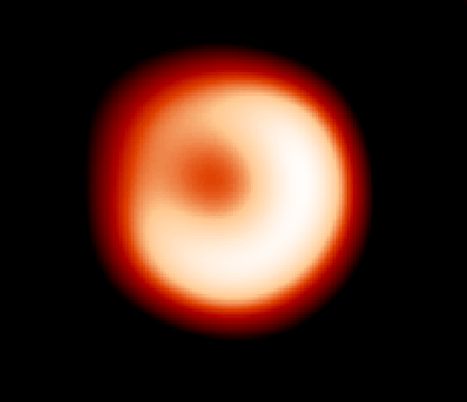Credit & Copyright: Peter
Tuthill
(Sydney
University Physics Department) et al.,
W.M. Keck Observatory
Explanation:
You'd need a really big cup of
coffee with this doughnut ...
because the hole in the middle is about a billion kilometers
across.
Centered on the Sun, a circle that size would lie
between the orbits of Mars and Jupiter.
In fact, this doughnut is known to surround a massive newborn star
cataloged as LkHa 101
which lies in the
constellation Perseus.
Imaged
in infrared light, the tantalizing torus-shaped cloud of gas
and dust
is slightly tilted to our view.
The cloud's material may well be the ingredients
for the formation of a
distant
solar system.
A bright source of
ultraviolet light,
the hot young star itself is much fainter in the
infrared and so not visible in this picture.
Still, the star's presence is indicated as its intense stellar wind and
radiation has apparently carved out the doughnut's hole.
This premier close-up of a stellar system in formation was accomplished
by adapting a powerful observational technique
called
interferometry to planet Earth's largest single mirror
telescope, the 10 meter Keck.
1999 2000 2001 2002 2003 2004 2005 2006 2007 2008 2009 2010 2011 2012 2013 2014 2015 2016 2017 2018 2019 2020 2021 2022 2023 2024 2025 |
Январь Февраль Март Апрель Май Июнь Июль Август Сентябрь Октябрь Ноябрь Декабрь |
NASA Web Site Statements, Warnings, and Disclaimers
NASA Official: Jay Norris. Specific rights apply.
A service of: LHEA at NASA / GSFC
& Michigan Tech. U.
|
Публикации с ключевыми словами:
звездообразование - extrasolar planet - инфракрасное излучение - infrared - dust cloud - star formation - doughnuts - планетная система - пылевое облако
Публикации со словами: звездообразование - extrasolar planet - инфракрасное излучение - infrared - dust cloud - star formation - doughnuts - планетная система - пылевое облако | |
См. также:
Все публикации на ту же тему >> | |
